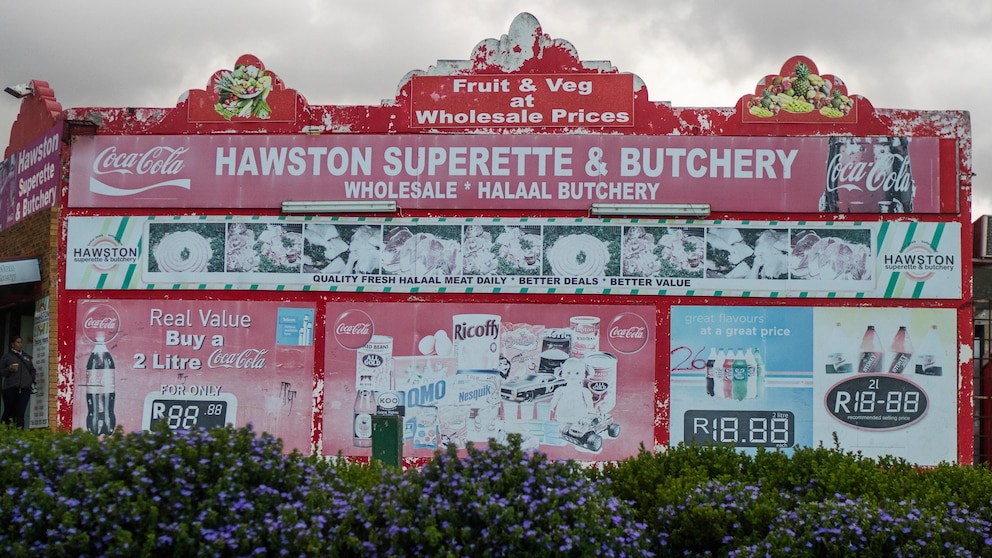







HAWSTON, South Africa — Nearly every house in Hawston has a boat in its yard, sometimes two.
It takes a moment to realize many are out of action, grass sprouting through holes in hulls that haven’t touched water for years. They are relics of another time, when people fished for their livelihood and the ocean provided more than enough.
Those languishing boats and other economic problems in Hawston are the result of changes in the market to South African abalone, a curious fist-sized sea snail that is a highly prized morsel in East Asia and the unwitting instigator of 30 years of trouble for fishing communities along Africa’s southern coast. Abalone here was abundant and especially tasty, yet the demand largely put the village and its traditional fishers out of business, or made them criminals overnight.
Raphael Fisher was born into fishing, as just about everyone was in Hawston. He grew up diving for the abalone that South Africans call perlemoen — or, affectionately, “perly” — in the rocky coves. He was learning to work his father’s boat in his late teens. Every boy wanted to be a perly fisher in Hawston, he said. It was the thing.
But over the last three decades, poachers have swept in and swept up every snail they could find — every sackful a fat payday. They can get $50 a kilogram. It’s reduced the endangered South African abalone to unprecedented low levels, wildlife groups say.
At first, the South African government banned abalone fishing completely. Now, strict quotas give Fisher and other small operators lucky enough to get them the rights to catch 120 kilograms a year. Hardly anything.
“The fishing has all been taken away,” he said. “It’s totally different now. They took the bread out of people’s mouths.”
It’s why a different poaching — not for big profits, but to put food on the table — has also ensnared so many traditional fishers up and down this coast. Fisher faced that temptation.
A 2022 report by the Global Initiative Against Transnational Organized Crime estimated the illegal trade heading to the hub of Hong Kong was worth nearly $1 billion between 2000 and 2016, and growing.
The total legal abalone fishing quota in South Africa is set at a maximum of 100 metric tons a year. Hong Kong is importing between 2,000-3,000 metric tons of illegal South African abalone a year, the report estimated. Some is moved on to other big markets in China, Japan and Taiwan.
Organized crime and turf battles over illegal abalone that are sometimes marked by brutal gang killings have overwhelmed South African coastal communities. Thousands of poor young men have been drawn in as foot soldiers.
Hawston and its troubles are likely unknown in Hong Kong, where the high-class Forum restaurant offers cooked South African abalone at $190 a can for customers to take away. Abalone is more than a delicious treat for millions of Chinese, said Wendy Chan, managing director at the Lamma Rainbow, a local seafood restaurant on Hong Kong’s Lamma Island.
“It carries a symbolic meaning,” Chan said. “After you have abalone, you will become wealthy or it will bring you good luck in the upcoming year.”
It’s a sign of prestige or something you would give as a gift. Chan also rates South African abalone highly, as so many do, with its rich taste and slightly chewy texture.
The International Union for Conservation of Nature says nearly half of all abalone shellfish species around the world are threatened with extinction, many affected by pollution and climate change and part of the larger story of devastation of marine wildlife.
Danie Keet, chairman of the Community Against Abalone Poaching group, has seen gang-related abalone poaching play out for 15 years in nearby Gansbaai, another South African coastal town. The poachers arrive in groups in broad daylight on pickup trucks and in their wetsuits, rubber duck boats towed behind them, he said.
It’s highly organized. Divers prize the abalone off the reefs and get them to shore in bags. Runners hide them in the dunes for others to take to stash houses. Lookouts watch for police and can warn the divers, who keep cellphones with them sealed watertight in condoms.
They are all the first cogs in a $60 million-a-year illicit business, according to the TRAFFIC Wildlife Trade Monitoring Network.
Keet said authorities don’t have the resources to patrol hundreds of miles of coastline and the poaching has become embedded.
“In the beginning they used to dive at night a lot. That changed as they noticed that they can just get away with it,” Keet said.
The demand has spurred an alternative to wild abalone — farmed abalone. HIK Abalone has a total of around 13 million abalone at any one time at their two south coast farms.
Abalone as far as the eye can see — from tiny specks to as big as your hand — in rows and rows of open-top tanks. None have felt the ocean or a rock. Here, they cruise surprisingly quickly under black plastic cones they have for underwater hiding places. They are bred, fed and set to be killed at the farm to be shipped, dried or canned, to Hong Kong, a few exported live for high-end customers.
Farms are tinkering with the abalone life cycle by selective breeding to get them to grow to a size they can be sold and eaten as fast as possible, said HIK CEO Bertus van Oordt.
“Our main aim is to get them bigger, faster,” van Oordt said.
The farms that have sprouted up have no role in conservation. Van Oordt said he would like to do something, but it’s unclear what effect the tank-bred abalone may have in the wild. Van Oordt said he is also unwilling to put abalone in the sea “to create a bigger poaching environment.”
“If the government comes up with a plan so we can protect what we put back in, we’ll be in,” van Oordt said. “We’ll give the abalone for free.”
Officially, authorities are sticking to fishing quotas for now, but there are signs of change after a government-led meeting of all players early this year, said Markus Burgener, a senior program coordinator at TRAFFIC. It was “the most positive development I’ve seen for years and years,” Burgener said.
The key, Burgener said, must be involving communities like Hawston instead of shutting them out.
Faced with the choice of his life when abalone fishing was banned and poaching ramped up, Fisher, 53, found another way. He works at the HIK farm.
His distrust of the system stems from the fact his father, a pioneer of Hawston’s fishing community for years, was denied a quota, his livelihood cut off with a swipe of a pen from someone in an office.
The younger Fisher’s job at HIK has enabled him to keep two small fishing boats going. They are guarded in his yard by two of his other prized assets, dogs Zara and Toby, growling precautions against the crime born out of the unemployment and poverty of Hawston.
Hawston’s harbor is broken-down, the scarcity of abalone leaving it far less used. A spray of graffiti on one of the walls still announces, “We Love Hawston.”
Fisher does fish his abalone quota, banding together in a small consortium with others to share costs, but it’s a part-time affair now. With sunglasses perched on top of a baseball cap, he scans the sky and the sea as his father might have, assessing what weather is coming and if he can go fishing this weekend. Not necessarily for abalone. Just fishing.
“When it’s in you, it’s in you,” he said.
___
Associated Press journalists Kanis Leung and Alice Fung in Hong Kong contributed to this report.
___
Follow AP’s climate and environment coverage at https://apnews.com/hub/climate-and-environment and Africa coverage at https://apnews.com/hub/africa
___
Associated Press climate and environmental coverage receives support from several private foundations. See more about AP’s climate initiative here. The AP is solely responsible for all content.

